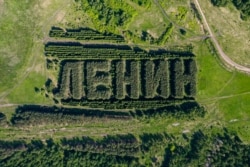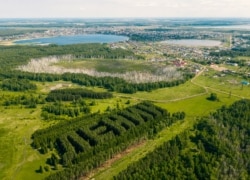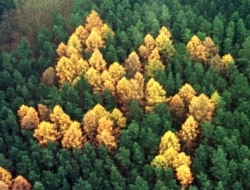Russian photographer Slava Stepanov was planning a business trip to Russia’s Omsk region in early June when he remembered an intriguing but blurry satellite photograph he had seen years ago.
Stepanov set aside a day from his Omsk schedule to drive to the town of Tyukalinsk and -- using Google Maps to guide him -- set up his drone to get a clearer look at a forest grove on the town’s marshy outskirts.
What the drone revealed in crisp detail as it rose above the marshy landscape was "awesome," Stepanov says. Stretching for 300 meters, in Cyrillic letters 82 meters high, was the name “Lenin” spelled with decades-old pine trees.
Vladimir Lenin was the founder and first communist leader of the Soviet Union. After his death in 1924, he became a kind of godhead of the Soviet Union.
Stepanov, who has studied the rarely photographed geoglyphs that are scattered throughout the former Soviet Union, says the trees were most likely planted in the 1970s for one of the many Soviet anniversaries when there was pressure to prove one’s dedication to the communist system.
"In the U.S.S.R., people were very focused on anniversaries, especially the birthday of Lenin and the anniversary of the 1917 October Revolution," Stepanov says. "Every factory, every enterprise, or even whole villages tried to somehow congratulate higher, stronger, more powerfully; to be more interesting and more noticeable than the rest. Among other things, there was an idea that communism would be eternal."
Three people in Tyukalinsk, including a local schoolteacher, spoke to RFE/RL. While all of them had heard of the Lenin forest, none were sure of when it was planted or why. The year 1970 would have marked the 100th anniversary of Lenin’s birth.
Forested political statements are not unique to Soviet totalitarianism. Adolf Hitler’s followers in Nazi Germany also famously planted trees that contrasted each autumn and spring with the evergreen pine trees around them to display a swastika.
The swastika grove was reportedly cut down in the early 2000s, but another remnant to European dictatorship remains today on a mountain above the Italian town of Antrodoco, near Rome.
During the reign of Italy’s fascist dictator Benito Mussolini the word "DUX," the Latin term for “Duce” (leader), was spelled out on the flank of Monte Giano. Each winter the snow makes the controversial testament to Mussolini visible from dozens of kilometers away.













